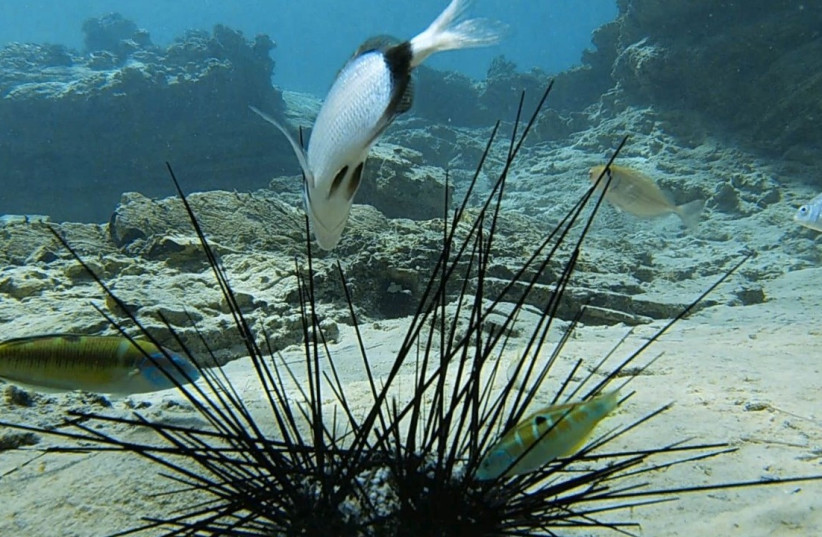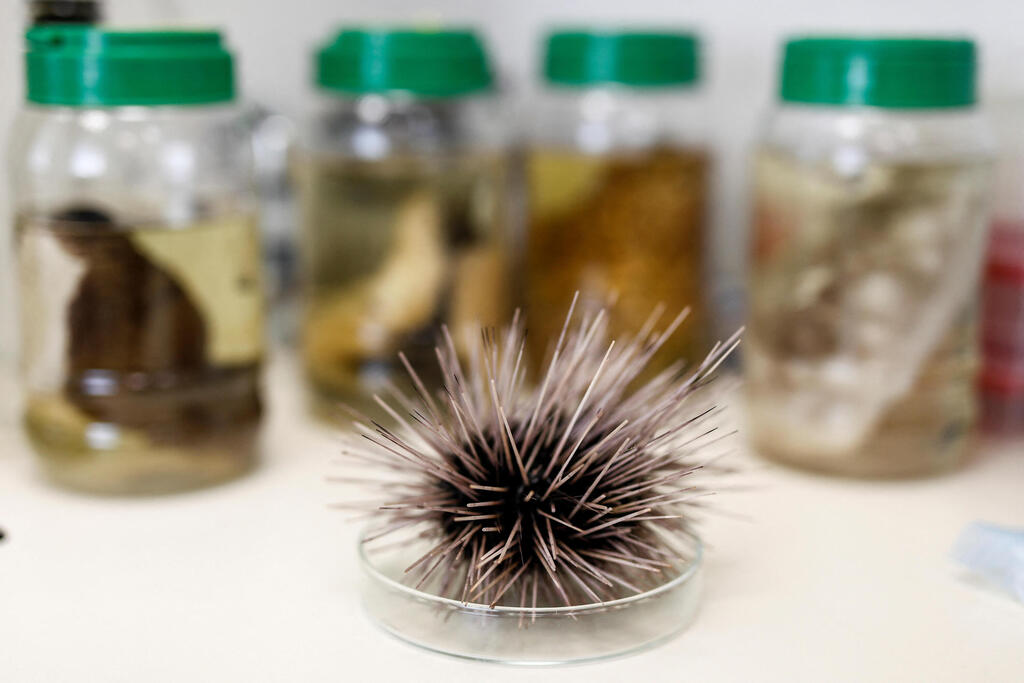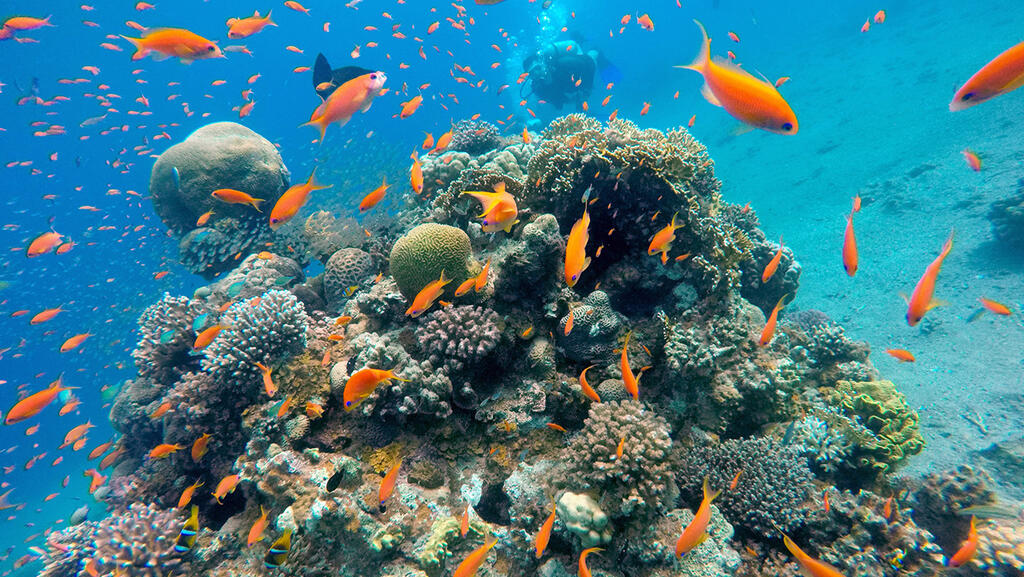Haaretz
Reuters. May 24, 2023
Entire Species of Sea Urchin Wiped Out in Gulf of Eilat, Israeli Researchers Find
Researches from Tel Aviv University warned Israeli environmental authorities about the extinction of the species, known for helping keep coral reefs healthy in Gulf of Eilat, citing fast and mass mortalities in border countries.
A deadly epidemic that is spreading through the Red Sea has killed off an entire species of sea urchin in the Gulf of Aqaba, imperiling the region’s uniquely resilient coral reefs, an Israeli research team has found.
The whole population of black sea urchins, a species known for helping keep coral reefs healthy in the waters also known as the Gulf of Eilat, was wiped out over a couple of months, according to a team from Tel Aviv University.
Their findings, published in two peer-reviewed journals, cite mass mortality in other countries in the region, including Jordan, Egypt and Saudi Arabia.
The probable culprit is a disease-causing ciliate parasite that brings with it a fast death – perhaps the same one that has wreaked havoc on sea urchin populations in the Caribbean.
In just two days, a healthy Diadema setosum – a long-spined black sea urchin – becomes a skeleton with massive tissue loss, said lead researcher Omri Bronstein, from Tel Aviv University’s Steinhardt Museum of Natural History and School of Zoology.
Some wash ashore dead. Others are eaten by fish, likely speeding up contagion.
The first signs of trouble appeared in the Mediterranean Sea, where the sea urchins have over the years invaded, probably through the Suez Canal, and made their home. Bronstein said there were reports several months ago from Greece and Turkey of sea urchin deaths.
While that was less concerning at first since they were an invasive species, the pathogen has now crossed back into the natural population in the Red Sea.
“There is nothing that can be done to stop this at the moment,” Bronstein said.
But there is a “very narrow window,” he said, to create an isolated population, or broodstock, of the sea urchins remaining elsewhere that could hopefully be reintroduced later on.
The researchers say a report to Israeli environmental authoritieshas been submitted and that emergency steps to protect the coral reefs are being examined.Open gallery view
Dr. Omri Bronstein holds a dead sea urchinCredit: Hadas Parush
Eilat, an Israeli resort town on the Red Sea’s northern shore, is a popular spot for scuba diving. Scientists studying the area consider it a coral refuge.
The corals that settled thousands of years ago had to pass through a narrow strait to the south that acted as a thermal barrier, ensuring they are more resistant to temperature increases that are threatening reefs globally.
The sea urchins play an important role in maintaining balance by feeding on algae that would otherwise block sunshine and smother the reefs.
“Coral stand no chance competing with algae. That’s why we need sea urchins,” he said. “Without this species, as we’ve seen – this is not imagination, we’ve seen it happening in front of our eyes – it is not a good future.”
Mass mortality of sea urchins threatens to destroy Eilat coral reef – Jerusalem Post
TAU researchers: a parasite is killing the sea urchins essential to the sustainability of coral reefs
Published: MAY 24, 2023

(photo credit: Courtesy of Tel Aviv University)
“The mass mortality of sea urchins in the Mediterranean Sea has spread to the Gulf of Eilat and threatens to destroy the coral reef,” a Tel Aviv University research team, led by Dr. Omri Bronstein, warns.
Sea urchins in general, and black sea urchins, known as Diadema setosum, in particular, are essential for coral reefs’ healthy functioning. Without them, a coral reef can become dominated and overcome by algae.
This story began two decades ago, when these sea urchins invaded from the Red Sea to the Mediterranean Sea off the coast of Turkey. Brownstein and his team followed the urchin invasion for about 15 years, including when the first one was discovered off the coast of Tel Aviv in 2016. Then, between 2018 and 2019, the situation started to change, and the small population of invading black sea urchins grew exponentially.
“They grew so much that, in some sites in southern Turkey, there are now populations of tens of thousands of individuals,” Brownstein explained. “This is called a population outbreak.”
Brownstein and the team were preparing to file a paper on why the Mediterranean environment was ripe for these species. But as they completed that report, they started hearing about mass sea urchin mortalities from colleagues in Turkey and Greece.
“As we worked on studies summarizing the invasion of sea urchins in the Mediterranean, we began to receive reports on sudden extensive mortality,” Brownstein said. “Supposedly, the extinction of an invasive species is not a bad thing, but we must be aware of two major risks: First, we don’t yet know how this mortality and its causes might impact local species in the Mediterranean; and second, and much more critical, the geographic proximity between the eastern Mediterranean and the Red Sea might enable the pathogen to quickly cross over to the natural population in the Red Sea. As we feared and predicted, this appears to have happened.”
Disappearance of sea urchins in the Caribbean
Brownstein and the team immediately started following this story, and the first thing they noticed was that something felt familiar about the situation. The mass mortality reminded the TAU team of the famous disappearance of sea urchins in the Caribbean.
“Until 1983, the Caribbean coral reef was a thriving tropical reef, quite similar to the coral reef in the Gulf of Eilat,” Brownstein said. “Once the sea urchins disappeared, the algae multiplied without control, blocked the sunlight from reaching the corals, and the entire reef changed irreversibly – from a coral reef to an algae field.“A group of researchers from Cornell University identified the cause of mortality in the Caribbean: a pathogenic ciliate parasite.
The pathology observed in the sea urchins dying in Greece and Turkey is identical to the pathology in the Caribbean, and it’s also the pathology we see in the sea urchins dying here in the Red Sea,” he said.
Brownstein described sea urchins as the “gardeners or lawnmowers” of the coral reef. As vegetarians, they eat large amounts of plant materials, ensuring a balance that allows the corals to thrive against the algae. Unfortunately, the situation has not improved four decades after the Caribbean pandemic.
“At first, we thought it was some kind of pollution or poisoning, or a local chemical spill, from the industry and hotels in the north of the Gulf of Eilat, but when we examined additional sites in Eilat, Jordan and Sinai, we quickly realized that this was not a local incident,” Brownstein stressed. “All findings pointed to a rapidly spreading epidemic. Similar reports are coming in from colleagues in Saudi Arabia.
“Even sea urchins that we grow for research purposes in our aquariums at the Interuniversity Institute and sea urchins at the Underwater Observatory Marine Park in Eilat contracted the disease and died, probably because the pathogen got in through the pumping systems,” he continued. “It’s a fast and violent death: within just two days, a healthy sea urchin becomes a skeleton with massive tissue loss. While some corpses are washed ashore, most sea urchins are devoured while they are dying and unable to defend themselves, which could speed up contagion by the fish who prey on them.”
This week, the first paper was published in Royal Society Open Science. A second report is expected to come out soon in Frontiers in Marine Science, and a third is underway, Brownstein said.The papers show how the entire population of black sea urchins in Eilat was wiped out over a few months, with similar extensive mortality also occurring in Jordan, Egypt, Saudi Arabia, Greece and Turkey.
The team has also submitted their report and recommendations for emergency steps to save the coral reefs to the Nature and Parks Authority.
“We must understand the seriousness of the situation: In the Red Sea, mortality is spreading at a stunning rate and already encompasses a much larger area than we see in the Mediterranean,” Brownstein said. “In the background, there is still a great unknown: What is actually killing the sea urchins? Is it the Caribbean pathogen or some new unfamiliar factor? Either way, this pathogen is clearly carried by water, and we predict that in just a short time, the entire population of these sea urchins in both the Mediterranean and the Red Sea will get sick and die.
“In my opinion, we must urgently establish a broodstock population for these sea urchins so that, if needed, we will be able to return them to nature in the future,” he said. “As with COVID-19, at this point, no one knows what will happen – will this epidemic disappear by itself, or will it stay with us for many years and cause a dramatic change in coral reefs? However, unlike the COVID-19 pandemic, in this case, we have no way of vaccinating or treating the sea urchins, and so we must focus all efforts on prevention.”
Brownstein warned that the window of preserving a healthy population of this species in Eilat has already closed, and if a broodstock is going to be established, it needed to be done yesterday.
“This is a complex task, but it is absolutely necessary if we wish to ensure the survival of this unique species that is so critical to the future of coral reefs,” he said. “The question is will decision-makers be faster than the disease? I am doing my best to make sure this is the case.”
https://www.jpost.com/environment-and-climate-change/article-744034
Red Sea corals threatened by mass sea urchin die-off – Naharnet

Sea urchins in Israel’s Gulf of Eilat have been dying off at an alarming rate, researchers announced Wednesday — a development that threatens the Red Sea’s prized coral reef ecosystems.
According to Tel Aviv University scientists, an unknown pathogen is killing off the black sea urchin, Diadema setosum. The massive die-off first began in the eastern Mediterranean Sea, from where it has spread to the neighboring Red Sea, the scientists said.
The black sea urchin is critical to maintaining a healthy reef habitat. Without them, algae grow unchecked, choking off corals and compromising the delicate balance of the reef ecosystem.
A paper outlining the findings was published Wednesday in the journal Royal Society Open Science.
“It’s a fast and violent death: within just two days a healthy sea urchin becomes a skeleton with massive tissue loss,” said Oren Bronstein, a marine biologist at Tel Aviv University and lead author on a series of papers on the sea urchin deaths.
He added that they have ruled out localized poisoning or pollution, and instead suspect a “rapidly spreading epidemic” caused by an as-yet-unidentified pathogen.
Last month, researchers in the United States identified a single-celled parasite responsible for a similar mass die-off of sea urchins in the Caribbean that has laid waste to reef ecosystems.
The Israeli researchers believe a similar pathogen might also be responsible for killing sea urchins in the Mediterranean and the Red Sea, and have called for urgent action by the Nature and Park Authority to protect Israel’s already endangered reef ecosystems.
“This new outbreak of disease is a grave concern,” said Ian Hewson, a professor at Cornell University’s Marine Mass Mortality Lab who was not involved in the Tel Aviv University study.
He added that it “would be interesting to know if the same agent is at work” in the Mediterranean as has been identified killing sea urchins in the Caribbean. “If that is the case it will raise questions about how it is vectored between such geographically separated sites.”
The Gulf of Eilat, a branch of the Red Sea shared by Israel, Jordan, Egypt and Saudi Arabia, is home to exquisite coral reefs that scientists believe might be more resilient to warming waters resulting from human-caused climate change.
Source Associated Press
https://www.naharnet.com/stories/en/297800-red-sea-corals-threatened-by-mass-sea-urchin-die-off
Red Sea epidemic kills off sea urchins, imperiling coral – YNET
Disease-causing ciliate parasite brings with it a fast death Researcher says there is a need to create isolated population, or broodstock, of the sea urchins remaining elsewhere to be reintroduced to the area, later on
A deadly epidemic that is spreading through the Red Sea has killed off an entire species of sea urchin in the Gulf of Aqaba, imperiling the region’s uniquely resilient coral reefs, an Israeli research team has found.

(Photo: Reuters)
The whole population of black sea urchins, a species known for helping keep coral reefs healthy in the waters also known as the Gulf of Eilat, was wiped out over a couple of months, according to a team from Tel Aviv University
Their findings, published in two peer-reviewed journals, cite mass mortality in other countries in the region, including Jordan, Egypt and Saudi Arabia.
The probable culprit is a disease-causing ciliate parasite that brings with it a fast death – perhaps the same one that has wreaked havoc on sea urchin populations in the Caribbean.
In just two days, a healthy Diadema setosum – a long-spined black sea urchin – becomes a skeleton with massive tissue loss, said lead researcher Omri Bronstein, from Tel Aviv University’s Steinhardt Museum of Natural History and School of Zoology.
Some wash ashore dead. Others are eaten by fish, likely speeding up contagion.
The first signs of trouble appeared in the Mediterranean Sea, where the sea urchins have over the years invaded, probably through the Suez Canal, and made their home. Bronstein said there were reports several months ago from Greece and Turkey of sea urchin deaths.
While that was less concerning at first since they were an invasive species, the pathogen has now crossed back into the natural population in the Red Sea.
“There is nothing that can be done to stop this at the moment,” Bronstein said.
But there is a “very narrow window”, he said, to create an isolated population, or broodstock, of the sea urchins remaining elsewhere that could hopefully be reintroduced later on.
The researchers say a report to Israeli environmental authorities has been submitted and that emergency steps to protect the coral reefs are being examined.
Eilat, an Israeli resort town on the Red Sea’s northern shore, is a popular spot for scuba diving. Scientists studying the area consider it a coral refuge.

The corals that settled thousands of years ago had to pass through a narrow strait to the south that acted as a thermal barrier, ensuring they are more resistant to temperature increases that are threatening reefs globally.
The sea urchins play an important role in maintaining balance by feeding on algae that would otherwise block sunshine and smother the reefs.
“Coral stand no chance competing with algae. That’s why we need sea urchins,” he said. “Without this species, as we’ve seen – this is not imagination, we’ve seen it happening in front of our eyes – it is not a good future.”
